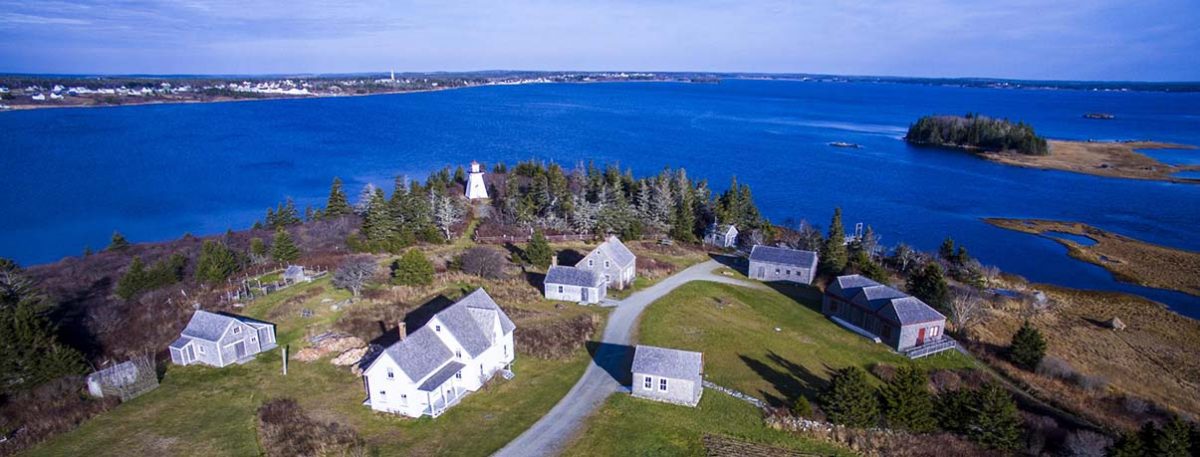
by John Geary
Walking into the visitor centre at the Historic Acadian Village of Nova Scotia is like walking through a time portal to life on the province’s southwest shores in the early 20th century.
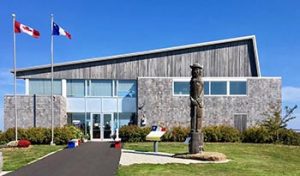 The centre is a modern facility, but once you step out its back doors, you’re walk back into history.
The centre is a modern facility, but once you step out its back doors, you’re walk back into history.
The Acadian people were actually the first to settle this area, back in the early years of the 17th century, when it was part of New France. They often had to deal with an uncertain existence during North America’s colonial history, as England and France fought for possession of North America.
As a result of a 1755 treaty from one of the many wars fought between the two 18th-century “superpowers,” the English removed many of the Acadians from their homes and re-settled them in their American colonies. Many ended up going to Louisiana, which was then a French territory and their descendants became what we refer to as Cajuns (“A-Cajuns”) in modern times.
KEEPING THE PAST ALIVE
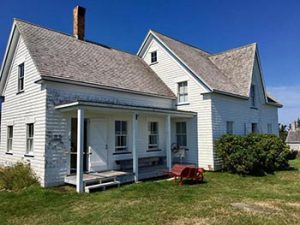 Today, many of the interpreters (costumed or otherwise) working at the Nova Scotia village are descendants of the area’s original inhabitants, who eventually made their way back to Nova Scotia, including the area around West Pubnico, not far from Yarmouth on the southwest shore of the province. They help make the village a living museum for visitors from June to October each year. Through them, you get to see how Acadians lived here during the early part of the 20th century as their culture grew and thrived. Many of them see this as an important way to keep their language and culture alive while sharing it with others.
Today, many of the interpreters (costumed or otherwise) working at the Nova Scotia village are descendants of the area’s original inhabitants, who eventually made their way back to Nova Scotia, including the area around West Pubnico, not far from Yarmouth on the southwest shore of the province. They help make the village a living museum for visitors from June to October each year. Through them, you get to see how Acadians lived here during the early part of the 20th century as their culture grew and thrived. Many of them see this as an important way to keep their language and culture alive while sharing it with others.
Upon first stepping through the time portal, one of the first buildings I encountered was the former home of one of the residents, Charles Duon. This house, built in 1832, was separated into two dwellings. The roof of the house’s main section originally had a gentle slope but was later raised. They then added a gable, which was common aspect of many Acadian homes.
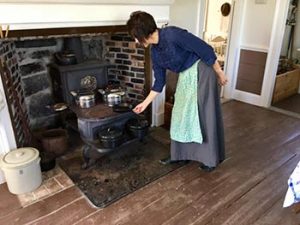 Walking through the building, I enjoyed not only viewing actual furniture and household appliances from the previous two centuries, but also watching interpreters going the processes of cooking, sewing, and cleaning as the people living then performed those tasks.
Walking through the building, I enjoyed not only viewing actual furniture and household appliances from the previous two centuries, but also watching interpreters going the processes of cooking, sewing, and cleaning as the people living then performed those tasks.
Watching them gave me a whole new appreciation for modern cooking methods and cleaning utensils.
I was really looking forward to seeing the boat shop, but I forced myself to see some of the other buildings that sat between the start of the dirt road through the village and that facility.
Continuing along the path toward the harbour, the next stop was the community post office. Originally built to provide a place to make shoes in the 1800s, it was turned into a community post office in the early 1900s. Today, you can still buy stamps and postcards at the village gift shop and have them mailed from the old post office – a postal time hop, in other words.
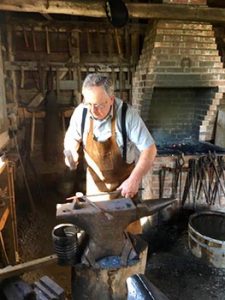 Of course, just about every historical village you visit has a blacksmith shop, and the Acadian Village is no different. The Reuben Trefry blacksmith shop opened for business back in the late 1800s and served the village until 1938. Today, you can watch the same kind of work being done as it’s been done through the centuries: the on-site blacksmith will heat up some metal, then pound it into shape on the anvil, creating various tools and other objects.
Of course, just about every historical village you visit has a blacksmith shop, and the Acadian Village is no different. The Reuben Trefry blacksmith shop opened for business back in the late 1800s and served the village until 1938. Today, you can watch the same kind of work being done as it’s been done through the centuries: the on-site blacksmith will heat up some metal, then pound it into shape on the anvil, creating various tools and other objects.
LET’S BUILD A BOAT!
And then…finally – I reached the boat shop!
I was not disappointed.
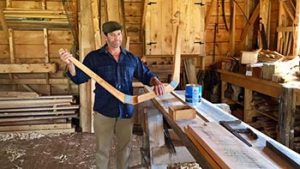 The carpenter who was working on building an actual wooden dory took time from his wood-working to answer questions and explain how flat-bottom boats were built traditionally for fishing the local waters during the early 1900s (apparently, the secret is in the ribs!) The time-tested techniques used then were obviously much different than those used in modern boats but given the materials and tools they used back then, the reasons for the processes they used all made perfect sense.
The carpenter who was working on building an actual wooden dory took time from his wood-working to answer questions and explain how flat-bottom boats were built traditionally for fishing the local waters during the early 1900s (apparently, the secret is in the ribs!) The time-tested techniques used then were obviously much different than those used in modern boats but given the materials and tools they used back then, the reasons for the processes they used all made perfect sense.
Just across the path from the boat shop sits the August Duon Fish Store (the Duons were obviously one of the prevalent families in the village!) There you could purchase dried, salted fish that had been processed at any of the several shops found along the shores.
Originally, the Acadians were agriculturalists, but when they returned, they often ended up settling on land that was not as suitable for agriculture as the land they’d previously lived on. Never ones to turn down a challenge, they turned to the sea to help them earn a living.
Now if you’re going to catch fish in any era, you need to have nets. Not all much has changed in that respect; what has changed is the types and size of nets used – and the way they’re repaired and maintained.
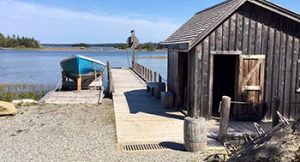 Dropping into the shanty by the shore at the end of the village path, you can see just how nets and lobster traps were repaired then. It was a tedious but crucial task to keep them in good shape in order to earn a living from the sea. Drop into the shanty, and you can watch nets being repaired the old-fashioned way, a process that probably had them swapping fish stories while they worked at it – and if you’re lucky, you’ll hear a few stories as well, as I did.
Dropping into the shanty by the shore at the end of the village path, you can see just how nets and lobster traps were repaired then. It was a tedious but crucial task to keep them in good shape in order to earn a living from the sea. Drop into the shanty, and you can watch nets being repaired the old-fashioned way, a process that probably had them swapping fish stories while they worked at it – and if you’re lucky, you’ll hear a few stories as well, as I did.
Next it was time for me to do a bit of “sitting on the dock of the bay.” A few steps away from the shanty is the crib style wharf, similar to the small docks that once dotted the shores in the area. Back then, fishermen had to plan their departure and return from fishing to coincide with the high tide in order to dock and unload their catch.
It was a gorgeous sunny day, a great opportunity to enjoy the views of the bay, watching modern-day kayakers paddle by, their plastic craft quite a contrast from the partially built wooden boat I’d seen earlier.
That was when I decided to check out the village’s nature trail. It’s a short little path that leads away from the shanty to an area that includes a seasonal salt marsh, great for seeing birds. However, when I visited, it was dry, so there was not really much bird life to see. There was a nice little picnic area, though, where one could sit and enjoy a snack, and watch the waters of the bay roll past.
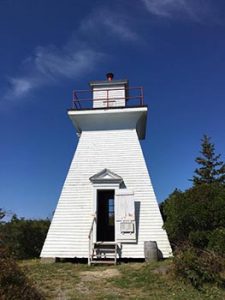 Backtracking past the shanty and across the main road, I followed another pretty path through the woods to visit the village lighthouse. Before heading there, I stopped to take a peek into the village’s root cellar. Opened as part of the village museum in 2017, the root cellar would have played an important role in the life of the Acadians of this region and surrounding areas. Built in the days before electricity, it kept vegetables from freezing in the winter months and kept food cool during the warmer summer months.
Backtracking past the shanty and across the main road, I followed another pretty path through the woods to visit the village lighthouse. Before heading there, I stopped to take a peek into the village’s root cellar. Opened as part of the village museum in 2017, the root cellar would have played an important role in the life of the Acadians of this region and surrounding areas. Built in the days before electricity, it kept vegetables from freezing in the winter months and kept food cool during the warmer summer months.
Then – on to the lighthouse! It was a short little walk…to a short little lighthouse. Built in the early 1900s on the mainland at Abbott’s Harbour, it was built to replace a lantern hoisted on a mast on Abbott Island.
Once I’d spent a bit of time checking out the lighthouse (I couldn’t actually go right inside it), it was time for me to head back through the woods and back along the dirt road path to the visitor centre to browse for some souvenirs and grab a snack before heading out.
As I drew closer to the centre, I saw a pair of cows munching on the grass contentedly in a fenced-in field not far from the doorway back to the present. I thought how little had changed for them through the past five centuries, as chewing their cuds in 1604 would be the same experience as chewing them in 2019.
DID YOU KNOW…
Some quick facts about Acadian culture:
Acadians have their own flag, which flies proudly at many places in the province – including outside the village.
Acadians have their own anthem.
There is a National Acadian Day, celebrated on June 19.
There is an Acadian World Congress. Southeastern New Brunswick and Prince Edward Island will host the next congress from August 10-24, this year.

 If You Go:
If You Go:
The village is only open from June 4 to September 28, but it’s open seven days a week during that time.
It is located at 91 Old Church Road, Lower West Pubnico, Nova Scotia. That’s about a 30-minute drive from Yarmouth; not quite three hours from Halifax (and an international airport).
This is their 20th anniversary, so they may some addition special events going on. To get details, you can contact them via email at villagehistorique@ns.aliantzinc.ca You can also phone Toll free at 1-888-381-8999.
You may also learn more about the village at the official website, levillage.novascotia.ca/
About the author:
John Geary is a professional freelance writer and photographer who specializes in travel, nature and wildlife, and history. He lives in Vancouver, B.C. Canada with his wife Ann and their three parrots, Coco, Congo, and Einstein. He previously wrote about the Yukon for TravelThruHistory.
Visitor Centre
The Duon House
Cooking the old fashioned way.
Blacksmith hard at work
The secret of building a good dory is in the ribs!
The shanty – lots of nets to fix, lots of stories to tell!
The lighthouse





Leave a Reply
You must be logged in to post a comment.